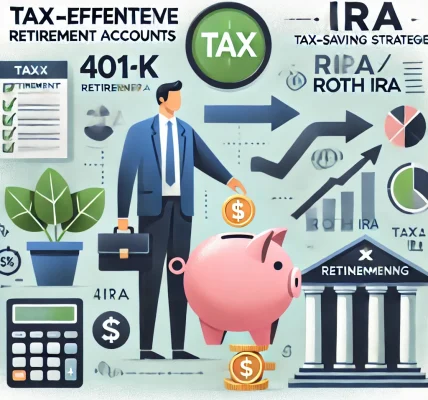When it comes to managing your finances, one of the most important factors to consider is reducing your tax liability. While taxes are a necessary part of life, there are several tax-saving investment options available that can help you keep more of your money and grow your wealth in the process. These options not only reduce your tax burden but also provide long-term financial benefits.
In this comprehensive guide, we will explore some of the best tax-saving investment options you can use to optimize your portfolio, save on taxes, and achieve your financial goals.
Why Tax-Saving Investments Matter
Before diving into the specifics, let’s understand why tax-saving investments are so important. Tax-saving investments allow you to reduce your taxable income and, in turn, lower the amount of tax you owe. They also offer the potential for tax-free or tax-deferred growth, which can significantly enhance your wealth over time.
By incorporating these options into your financial strategy, you can:
- Minimize your taxable income.
- Take advantage of government incentives for long-term savings.
- Maximize your returns by reducing your tax obligations.
Let’s take a look at some of the top tax-saving investment options you should consider.
1. Public Provident Fund (PPF)
One of the most popular and secure tax-saving instruments in India is the Public Provident Fund (PPF). The PPF is a long-term savings plan backed by the government, offering tax-free returns and several tax benefits.
Tax Benefits:
- Contributions to the PPF are eligible for a tax deduction under Section 80C of the Income Tax Act.
- The interest earned and the maturity proceeds are completely tax-free.
Why It’s a Good Choice:
- Safety: The PPF is backed by the government, making it a low-risk investment.
- Long-Term Growth: PPF has a lock-in period of 15 years, encouraging long-term savings.
- Tax-Free Returns: The interest earned on the PPF is tax-free, which can compound over time.
2. Employees’ Provident Fund (EPF)
If you’re employed, you’re likely already contributing to the Employees’ Provident Fund (EPF). Like the PPF, the EPF offers excellent tax-saving benefits.
Tax Benefits:
- Contributions to EPF are eligible for tax deductions under Section 80C.
- The interest earned and the amount withdrawn at the time of retirement are tax-free, provided certain conditions are met.
Why It’s a Good Choice:
- Employer Contribution: In addition to your own contribution, your employer also contributes to the EPF, helping you save more.
- Long-Term Security: EPF is a safe option and provides a steady stream of income after retirement.
3. National Savings Certificate (NSC)
The National Savings Certificate (NSC) is a government-backed investment scheme that offers tax-saving benefits and a fixed interest rate.
Tax Benefits:
- Contributions to the NSC qualify for a tax deduction under Section 80C.
- The interest earned on the NSC is taxable, but it is reinvested and added to the principal, which means it continues to grow until maturity.
Why It’s a Good Choice:
- Fixed Returns: NSC offers fixed returns, which provide a sense of security.
- Low Risk: Being backed by the government, NSC is a low-risk investment option.
- Ideal for Risk-Averse Investors: If you prefer safe, predictable returns, the NSC is a good option.
4. Tax-Saving Fixed Deposits (FDs)
Tax-saving Fixed Deposits are a type of fixed deposit that offers tax benefits under Section 80C of the Income Tax Act. These FDs come with a lock-in period of 5 years.
Tax Benefits:
- Contributions are eligible for a tax deduction under Section 80C.
- The interest earned on the FD is taxable, but the principal invested is deducted from your taxable income.
Why It’s a Good Choice:
- Security: Fixed deposits offer capital protection, ensuring that your principal is safe.
- Guaranteed Returns: You know exactly how much you will earn by the end of the term.
- Simple to Open: Tax-saving FDs can be easily opened at most banks and financial institutions.
5. Sukanya Samriddhi Yojana (SSY)
For parents who want to save for their daughters’ future, the Sukanya Samriddhi Yojana (SSY) is an excellent tax-saving investment option.
Tax Benefits:
- Contributions to SSY are eligible for tax deductions under Section 80C.
- Interest earned on the SSY account is tax-free, and the maturity amount is also tax-free.
Why It’s a Good Choice:
- High Returns: SSY offers one of the highest interest rates among government-backed schemes.
- Tax-Free Growth: Both interest earned and maturity benefits are tax-free.
- Focused on Girls’ Education: SSY is designed to encourage savings for a girl child’s education and marriage.
6. Equity-Linked Savings Scheme (ELSS)
For those willing to take a little more risk in exchange for higher returns, Equity-Linked Savings Schemes (ELSS) are a great option. ELSS are mutual funds that primarily invest in equities, providing the potential for higher returns over the long term.
Tax Benefits:
- Contributions to ELSS qualify for tax deductions under Section 80C.
- The returns earned on ELSS are subject to Long-Term Capital Gains Tax (LTCG), but gains up to ₹1 lakh in a financial year are tax-free.
Why It’s a Good Choice:
- Higher Returns: Since ELSS invest in the stock market, they offer higher returns compared to other traditional investment options.
- Tax Deduction: ELSS offers the benefit of tax deduction under Section 80C.
- Shorter Lock-In Period: ELSS has a 3-year lock-in period, which is the shortest among tax-saving instruments.
7. Unit Linked Insurance Plans (ULIPs)
Unit Linked Insurance Plans (ULIPs) combine both insurance and investment, offering tax benefits along with the opportunity to invest in equities, debt, or a mix of both.
Tax Benefits:
- Contributions to ULIPs are eligible for tax deductions under Section 80C.
- The maturity amount is tax-free under Section 10(10D), provided certain conditions are met.
Why It’s a Good Choice:
- Dual Benefits: ULIPs offer the dual benefit of life insurance and investment.
- Flexibility: You can switch between different funds (equity, debt, or balanced) based on your risk appetite.
8. Health Insurance (Section 80D)
While not a traditional investment, health insurance is another important tax-saving tool. Premiums paid for health insurance are eligible for deductions under Section 80D.
Tax Benefits:
- Deductions up to ₹25,000 for premiums paid for yourself, your spouse, and children.
- Additional deductions for premiums paid for parents (up to ₹50,000 if they are senior citizens).
Why It’s a Good Choice:
- Protect Your Health and Finances: Health insurance provides financial security in case of medical emergencies.
- Tax Deduction: It offers a direct tax saving for premiums paid.
Conclusion
Tax-saving investments are essential to reducing your tax liability and growing your wealth over time. By utilizing tax-saving options like PPF, EPF, ELSS, and more, you can build a strong financial foundation while taking advantage of the tax benefits provided by the government. Be sure to assess your financial goals, risk tolerance, and investment horizon before choosing the right tax-saving investment option for you.




